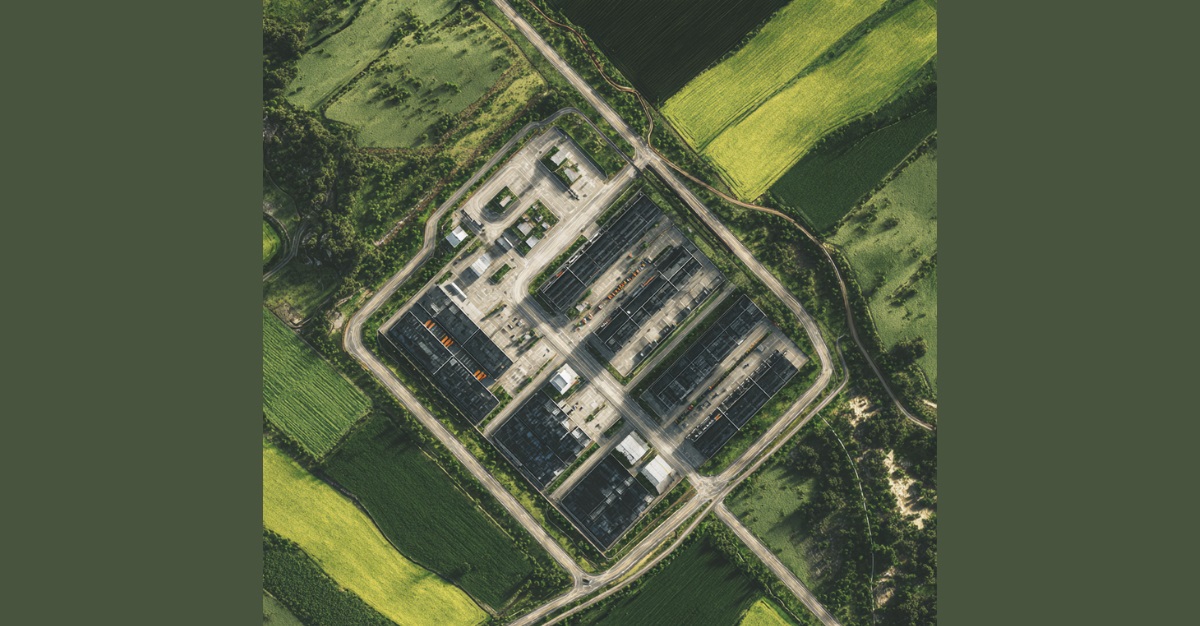Why Light Design modules beat flexible modules for C&I rooftops

Date
August 26, 2025
read time
5
Minutes
Subscribe to the LONGi Newsletter
Flexible modules have been promoted for low-load roofs and are frequently used in commercial projects such as museums and factories. They solve weight but introduce new risks around performance, warranties, thermal performance, and wind and fire compliance.
How do flexible modules compare to ultra-lightweight modules like the Hi-MO X10 Guardian Light Design?
What are flexible modules?
Flexible, bendable panels are thin, lightweight laminates that generate electricity. On average, typical flexible panels are about an inch thick and weigh around six pounds, which equals roughly 2.7 kilograms per panel. They can flex to around 30 degrees, which lets them follow curved or uneven surfaces. For the residential segment, they are suitable for the roofs of vans and trailers, boat decks or other mobile applications. C&I applications primarily use flexible solar modules where conventional modules cannot, or can only with difficulty, be installed due to shape or weight constraints.
What counts as “flexible” on rooftops
Lightweight PV options for C&I rooftops generally fall into two categories:
- Glassless crystalline-silicon modules, built on composite backplanes, which significantly reduce weight and can be mounted with conventional clamps. Some designs allow adhesive mounting, though clamping remains standard for safety and replacement reasons. This segment has become the dominant lightweight solution in the market.
- Thin-film laminates such as CIGS, which are flexible and can be directly applied to metal or membrane roofs. However, due to declining production and limited availability, CIGS is now a niche technology compared to lightweight crystalline silicon.
The combination of clamps for flexible modules is common. Adhesive-only systems have not scaled in Europe because of safety, maintenance, and insurance issues. Also, for C&I owners, being able to replace a module or prove long-term fire safety is critical. That’s why most mainstream lightweight crystalline-silicon modules today are designed for clamp mounting, with adhesives remaining a niche. So, installation is straightforward. But that convenience comes with trade-offs.
Why some businesses think flexible modules are an option
Vendor case studies and industry presentations have created the perception that flexible PV is a go-to fix for delicate or thin-sheet roofs. Other market players also pitch C&I unlock stories at trade events, reinforcing the idea that “lightweight equals flexible”. The interest is real because many C&I buildings face structural limits. A closer look reveals that flexible modules are rarely a viable choice for C&I installations.
The fine print that makes flexible a poor C&I choice
Flexible PV sounds handy, but for European commercial roofs the details don’t add up: lower module efficiency, harsher operating temperatures, weaker mechanical ratings, and shorter warranties stack the odds against bankable, long-life performance. Insurers and standards bodies require system-level proof for wind, hail, and fire, a bar many flexible offerings do not meet.
LONGi’s Hi-MO X10 Guardian Light Design is built to meet those C&I expectations, with higher efficiency, stronger loads, better hot-spot behavior and long warranties, without asking building owners to accept extra risk.
Here’s how the trade-offs of flexible modules stack up against rigid alternatives – and in particular the Hi-MO X10 Guardian Light Design.
Close mounting makes flexible modules run hotter and yield less
Flexible modules sit directly on the roof with little or no gap, so the roof heats up in the sun and transfers that heat straight into the module, and with no space for air to move the heat builds up. Rigid, clamp mounted modules keep a larger gap, often 10–15 cm, which limits that heat build up. Higher operating temperature not only cuts output on the day, it also raises the chance of hotspots and speeds up ageing of plastics, solder joints and connections over time. Most flexible designs have a temperature coefficient of about −0.33 to −0.40% per °C, so every 10 °C rise trims roughly 3–4% of available power, and on hot summer roofs cells can run 20–30 °C above test conditions, which means roughly 6–12% extra loss when you need energy most.
By contrast, the Hi-MO X10 Guardian Light Design is clamp-mounted to standard rails with long-side, A-side frame clamping using approved mid and end clamps, maintaining a defined roof gap. Its Pmax temperature coefficient is −0.26% per °C, limiting summer heat on the power output. Additionally, the HPBC 2.0 back contact architecture includes a shading optimizer technology and weak-conduction design that lowers hotspot temperatures by about 28 percent and lets shaded cells recover over 70 percent more power compared with conventional designs, improving safety and yield on busy C&I roofs. Together with an IEC fire rating, these features make Light Design the cooler-running, safer and more bankable choice for European rooftops.
Flexible modules have a lower energy yield: The module technology sets efficiency and power output
Flexible modules use either thin-film CIGS or ultra-thin crystalline cells on polymer backings. Recent reviews and field studies place flexible CIGS modules typically in the ~15–18% efficiency range, while glass-free crystalline flexible modules land around ~19%. Efficiency translates directly into roof power, 15–19.5% means roughly 150–195 W per square metre.
By contrast, the single-glass Light Design module reaches 24.8% efficiency and about 250 W/m² in production. In plain terms: flexible formats start from a lower technical ceiling and deliver fewer watts on the same roof area, which rolls through to lower year-one and lifetime kWh on space-constrained C&I roofs.
Flexible modules offer limited mechanical resilience when exposed to snow loads, wind uplift, and hail impact
Flexible modules are lighter, but they’re also easier to bend, dent and bruise. Many are only rated around 2400 Pa for static load, which leaves little safety margin when Europe sees heavy snow or strong winds. In severe hailstorms, which can bring 30–50 mm stones in the DACH region (with 20–30 mm more common in strong events), thin polymer surfaces are more prone to impact damage and surface cracking.
High winds add another risk, uplift, at roof edges and corners suction forces try to peel modules away. In European wind design standards, rooftop edge and corner zones can experience uplift pressures of roughly 1,500 to 3,000 Pa, depending on building height, location, and exposure category. Season after season, that movement can fatigue cells and conductors, loosen fixings, and turn small issues into bigger failures and more repairs.
The Hi-MO X10 Guardian Light Design is built for real roof loads, tested to 5,400 Pa on the front and 2,400 Pa on the rear, and to a hail impact of 25 mm at 23 m/s, giving comfortable headroom for heavy snow and storm conditions on European C&I roof. Despite the low dead load, about 16.3 kg per module, roughly 7.2 kg/m², the frame and reinforced stack preserve stiffness for service traffic and long spans.
The hot-spot risk with flexible modules is real - partial shade can run dangerously hot
Partial shading on rooftops from parapets, vents, or aerials can create hotspots where local cell temperatures rise above 100 °C, in some cases approaching 130 °C. Such elevated temperatures accelerate material degradation and, if unmanaged, can increase the likelihood of safety issues including fire. Independent studies and IEA PVPS reports (International Energy Agency Photovoltaic Power Systems Programme) have documented these effects across different PV technologies.
This repeated thermal stress cooks plastics and weakens solder joints, which can cause permanent power loss, bypass diode failures and insulation damage, and in the worst cases arc faults and fires.
LONGi’s HPBC 2.0 back-contact design in the Light Design module addresses the issue, cutting hot-spot temperatures by ~28% and recovering ~70% more power under identical shading versus conventional cells - meaning safer, steadier output on complex C&I roofs.
Degradation: Heat and stress accelerate losses in flexible modules - thin films age faster
Flexible modules start at a disadvantage on lifetime stability: field reviews show thin-film and polymer-heavy stacks degrade more and with wider spread, often around ~0.7–1.0% per year, with published ranges from ~0.5% up to ~2% per year depending on product generation, mounting and climate. By comparison, rigid lightweight glass-front modules typically degrade about 0.5–0.6% per year, similar to standard crystalline modules in large studies.
The Hi-MO X10 Guardian Light Design carries a 30-year performance warranty that guarantees about 99% after year one and around 88–89% at year 30, which corresponds to roughly 0.35% per year after year one. Over a 25 to 30 year operating life, this profile compounds into higher delivered energy for rigid lightweight systems like Light Design.
Flexible module warranties fall short of C&I horizons
For flexible modules, published datasheets typically offer a 5–12-year product warranty and a 25-year linear power warranty that ends around ~84–85% of initial output.
Conventional lightweight, glass-free modules typically carry a 10–16-year product warranty and a 25-year linear performance warranty, starting at around 98% in year one and degrading by roughly 0.55% annually, ending at about 80–85% of initial output.
For C&I projects planned over 25–30 years, this shorter coverage and lower guaranteed end-of-term output reduce the bankable horizon, tighten lender assumptions, and increase reserves for replacements and downtime.
By contrast, the Hi-MO X10 Guardian Light Design offers a 15-year product warranty and a 30-year performance warranty to about 88.9% at year 30, which better matches depreciation schedules and supports more predictable lifetime cash flow. Stronger warranty terms reduce lifetime risk for EPCs, owners and lenders.
Conclusions for European C&I buildings
Flexible modules have their niche, but on regulated, insured commercial roofs they underperform in efficiency, thermal behavior, mechanical ratings, and warranty strength. Their lower hail and wind resilience, shorter product guarantees, and reduced end-of-warranty output create additional bankability concerns.
The LONGi Light Design module that just launched offers a true low-load solution for these rooftops, combining a high-efficiency back-contact platform with higher mechanical load resistance (up to 5,400 Pa front / 2,400 Pa rear), improved hotspot management, and a 15-year product warranty with a 30-year performance warranty. For businesses with large-span buildings such as logistics centers, warehousing facilities, production halls, retail complexes, airports, or sports venues, the module provides a safe and reliable pathway to unlock roof space that would otherwise remain unused. Together with cost advantages of up to €200,000 per MW by avoiding roof reinforcement, it is the fit-for-purpose option. For developers, investors, and building owners, this means more reliable kWh, stronger risk protection, and a lower levelized cost of electricity over the full asset life.





